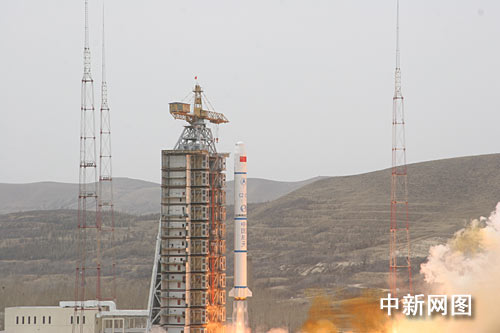China launches 2nd oceanic survey satellite
时间:2007-04-12 02:25:37
(单词翻译:单击)

| China launched its self-made "Haiyang-1B" oceanic survey satellite from the Taiyuan Satellite Launch Center in Shanxi Province at 11:27 am Wednesday, April 11, 2007. |
| Apr.11 - China successfully launched its second oceanic survey satellite "Haiyang-1B" (Ocean 1B) from Taiyuan Satellite Launching Center on Wednesday.
The China-made satellite was launched at 11:27 a.m. and reached the target orbit aboard a Long March-2C carrier rocket, China's most senior ocean research official said. The "Haiyang-1B", a crucial component1 of China's three dimensional oceanic survey system, would be used to monitor the color and temperature of the ocean, said Sun Zhihui, director of the State Oceanic Administration. The satellite would aid China's development and utilization2 of oceanic resources, construction of ports, monitoring and prevention of oceanic pollution, resource investigation3 and the development of coastal4 areas as well as for study of global environmental changes, he said. China launched its first oceanic survey satellite "Haiyang-1A" in May 2002 to monitor ocean color and temperature using remote sensing technology "Haiyang-1A" monitored the Bohai Sea, the Yellow Sea, the East China Sea and the South China Sea. Chief scientist Bai Zhaoguang said the "Haiyang-1B" is an upgraded version of the earlier model. "The operational life of 'Haiyang-1B' is expected to reach three years, a year longer than 'Haiyang-1A'. The new satellite provides three times as much information," he said. "The satellite's observational devices now have a 3,000-kilometer range -- up from 1,300 kilometers -- and its imaging devices provide higher resolution photography," he added. Haiyang-1B had a stronger structure than Haiyang-1A, enabling it to withstand stronger shocks and jolts5, he said. Bai said the Haiyang-1B had software and Internet capabilities6 that allowed it to repair itself in space, saying 10 computers worked together to repair the spacecraft in the event of a technical breakdown7. The breakdown of a solar cell driver shortened Haiyang-1A's operational life. But Haiyang-1B's improved technology would enable it to solve this kind of problem by itself, Bai said. The "Haiyang-1A", China's first experimental satellite to use ocean color detecting, worked for 685 days from May 2002 to April 2004 with an operational life shorter than the designed lifespan of two years. During its operation, it completed 1,830 surveys and provided oceanic information for 126 users including the oceanic administration, producers of oceanic products, research institutes and universities. SOA director Sun Zhihui said China would develop five more oceanic satellites in the medium term, saying satellites were urgently needed to develop the country's marine8 economy, provide a marine early warning system and safeguard the nation's maritime9 rights. "Haiyang-1B" is developed by the China Academy of Space Technology of China Aerospace10 Science and Technology Corp (CASTC). It was launched on the 96th flight of a Long March carrier rocket, which was developed by the China Academy of Launch Vehicle Technology of the CASTC.
|
点击 收听单词发音
收听单词发音
 收听单词发音
收听单词发音
1
component

|
|
| n.组成部分,成分,元件;adj.组成的,合成的 | |
参考例句: |
|
|
|
2
utilization

|
|
| n.利用,效用 | |
参考例句: |
|
|
|
3
investigation

|
|
| n.调查,调查研究 | |
参考例句: |
|
|
|
4
coastal

|
|
| adj.海岸的,沿海的,沿岸的 | |
参考例句: |
|
|
|
5
jolts

|
|
| (使)摇动, (使)震惊( jolt的名词复数 ) | |
参考例句: |
|
|
|
6
capabilities

|
|
| n.能力( capability的名词复数 );可能;容量;[复数]潜在能力 | |
参考例句: |
|
|
|
7
breakdown

|
|
| n.垮,衰竭;损坏,故障,倒塌 | |
参考例句: |
|
|
|
8
marine

|
|
| adj.海的;海生的;航海的;海事的;n.水兵 | |
参考例句: |
|
|
|
9
maritime

|
|
| adj.海的,海事的,航海的,近海的,沿海的 | |
参考例句: |
|
|
|
10
aerospace

|
|
| adj.航空的,宇宙航行的 | |
参考例句: |
|
|
|
©2005-2010英文阅读网




